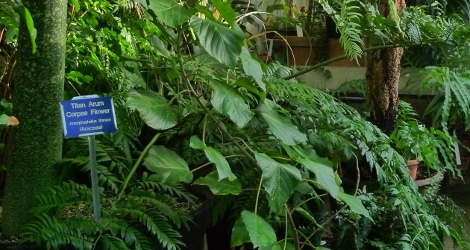Accession Data:
Guarea kunthiana A. Juss.
- Common Name: Cocora
- Family: Meliaceae Juss.
- Country of Origin: Ecuador
- Habitat: common in mature cloud forests and swamps
- Description: Young branches often canaliculate, usually minutely appressed puberulent less frequently sparsely to densely softly pubescent, soon becoming glabrous, brown to greyish-brown, without lenticels. Leaves petiole or axis; also applied to how the lateral veins are arranged in relation to the main vein.">pinnate with a terminal bud showing some intermittent growth, rarely unifoliolate, 7.5-35(-100) cm long; petiole semi-terete, rhachis canaliculate above, appressed puberulous or less frequently pubescent becoming glabrous; petiolule (1-)2-5(-10) mm long. Leaflets 2-6(-10) pairs, broadly to narrowly elliptic or oblanceolate, apex obtusely cuspidate to short or long attenuate less frequently acuminate, obtuse, or rounded, base acute, cuneate, or attenuate rarely rounded or truncate, chartaceous to subcoriaceous, (10-) 15-25(-34)[18.7] cm long, (3.5-)5-10(-20)[7.9] cm broad, usually glabrous less frequently lower surface sparsely to densely puberulous or softly pubescent (erect hairs), usually obscurely glandular-punctate and -striate; venation eucamptodromous, midrib flat; secondaries 8-12(-24) on either side of midrib, ascending, arcuate above, ± parallel or slightly convergent; intersecondaries absent or if present then short and inconspicuous; tertiaries widely spaced and obscure. Inflorescence usually axillary, occasionally supra-axillary or lateral on young wood, indeterminate with intermittent growth from apex, (1-)3.5-25(-30) cm long, a slender to broadly pyramidal thyrse with lower branches to 12 cm long, minutely appressed puberulous to sparsely or densely pubescent. Pedicel (1-)2-3(-4) mm. Calyx cyathiform to patelliform, 1.5-3(-5) mm long, with (3-)4 irregularly rounded, obtuse or less frequently acute lobes, 0.5-2.5 mm long or margin ± truncate, sparsely appressed puberulous outside. Petals (3-)4, valvate, (6-)7-12(-13.5) mm long, 1.5-4(-4.5) mm broad, oblong to lanceolate, apex acute and often hooded, densely appressed puberulous or appressed pubescent outside, glabrous inside. Staminal tube often slightly narrowed at apex, 5.5-10 mm long, (1.5-)2-3(-4) mm broad, margin truncate, undulate, or crenulate, glabrous or sparsely to moderately appressed puberulous outside, glabrous inside; anthers (7-)8(-10), (1-) 1.2-1.8 (-2) mm long. Nectary broadly stipitate, sometimes expanded to form an annulus below ovary, 0.5-2.5(-3) mm long, glabrous. Ovary ovoid, (3-)4-locular, loculi with 2 superposed ovules (Cuatrecasas 13155 from Colombia has uniovulate loculi), glabrous or rarely sparsely strigose; style glabrous. Capsule ellipsoid to globose sometimes ± quadrangular in section or often irregularly shaped, apex rounded to acute sometimes apiculate, base acute to rounded sometimes with a very short stout stipe, smooth or rarely obscurely verrucose, usually with large pale lenticels, glabrous, 1.5-4.5(-7.5) cm long, 1.5-3.5(-6.5) cm broad, 4-valved, valves with 2 superposed seeds; pericarp 1-4 mm thick, leathery. Seeds 1-2, ellipsoid when solitary or when superposed then upper truncate at base and lower at apex, to 2.5 cm long, 1.8 cm broad, surrounded by a fleshy sarcotesta thickened on adaxial surface; seed coat thick, woody. Hilum large, extending length and breadth of adaxial surface. Embryo with thick plano-convex, superposed cotyledons; radicle abaxial, extending to surface.7
- Uses: The juice of the crushed bark of this tree is used in Ecuador in the treatment of malaria. It is also used to treat post-natal depression and reputed to be good for the treatment of asthma.
- USDA Zone: 9-11?
Accession Data:
- Accession # 200500043
- Source: Tom Lemieux - UC Boulder
- Provenance:
Grown from seed - wild collected by Tom Lemieux #2179, B45 18Jan01. UC-Boulder# 01.052
- Accession Date: 06-16-2005
- Bench: 1305 - NEOA: Ground Bed 1 NW
- Currently: active - healthy
- Qty: 1 confirmed on 10-08-2024
Classification:
- Division: Magnoliophyta
- Class: Magnoliopsida
- SubClass: eurosid II
- Order: Sapindales
- SubOrder:
- Family: Meliaceae
- SubFamily: Melioideae
- Tribe:
- SubTribe:
Flowering Data:
This accession has been observed in bloom on:| Year | Jan | Feb | Mar | Apr | May | Jun | Jul | Aug | Sep | Oct | Nov | Dec | ||||||||||||||||||||||||||||||||||||||||
|---|---|---|---|---|---|---|---|---|---|---|---|---|---|---|---|---|---|---|---|---|---|---|---|---|---|---|---|---|---|---|---|---|---|---|---|---|---|---|---|---|---|---|---|---|---|---|---|---|---|---|---|---|
| 2024 | ||||||||||||||||||||||||||||||||||||||||||||||||||||
| 2023 | ||||||||||||||||||||||||||||||||||||||||||||||||||||
| 2022 | ||||||||||||||||||||||||||||||||||||||||||||||||||||
| 2021 | ||||||||||||||||||||||||||||||||||||||||||||||||||||
| 2020 | ||||||||||||||||||||||||||||||||||||||||||||||||||||
| 2019 | ||||||||||||||||||||||||||||||||||||||||||||||||||||
| 2018 | ||||||||||||||||||||||||||||||||||||||||||||||||||||
| 2017 | ||||||||||||||||||||||||||||||||||||||||||||||||||||
| 2016 | ||||||||||||||||||||||||||||||||||||||||||||||||||||
| 2015 | ||||||||||||||||||||||||||||||||||||||||||||||||||||
| 2014 | ||||||||||||||||||||||||||||||||||||||||||||||||||||
| 2013 | ||||||||||||||||||||||||||||||||||||||||||||||||||||
| 2012 | ||||||||||||||||||||||||||||||||||||||||||||||||||||
| 2011 | ||||||||||||||||||||||||||||||||||||||||||||||||||||
References (internal):
References (external):
- Fisher, J.B., Su n and Shade Effects on the Leaf of Guarea (Meliaceae): Plasticity of a Branch Analogue, Botanical Gazette, Vol. 147, No. 1. (Mar.,1986), pp. 84-89. (JSTOR archive - subscription required)
- Skutch, A.F., A Compound Leaf with Annual Increments of Growth, Bulletin of the Torrey Botanical Club, Vol. 73, No. 6. (Nov. - Dec., 1946), pp. 542-546. (JSTOR archive - subscription required)
- Steingraeber, D.A.; Fisher, J.B. Indeterminate Growth of Leaves in Guarea (Meliaceae): A Twig Analogue, American Journal of Botany, Vol. 73, No. 6. (Jun., 1986), pp. 852-862.(JSTOR archive - subscription required)
- Wenny, D.G., Two-Stage Dispersal of Guarea glabra and G. kunthiana (Meliaceae) in Monteverde, Costa Rica, Journal of Tropical Ecology, Vol. 15, No. 4. (Jul., 1999), pp. 481-496. (JSTOR archive - subscription required)
- The Plant List (2013). Version 1.1. Last accessed on Wednesday, August 15, 2018.
- Guarea kunthiana at Tropical Plants Database, Ken Fern. Last accessed Wednesday, 19 December, 2018.
- Guarea kunthiana at World Flora Online (NYBG). Last accessed Wednesday, 19 December, 2018.
data regenerated on Tue, 08 Oct 2024 12:54:42 -0400 [bcm v4.0]
Images:

Additional images for this accession:
Click on thumbnails to enlargeCurrent Accessions in the Meliaceae
Subfamily Cedreloideae
Subfamily Cedreloideae
Tribe Cedreleae
Subfamily Melioideae
Subfamily Melioideae
Tribe Melieae
Subfamily Melioideae
Tribe Turraeeae
W/C = Wild Collected
 = indicates flowering in past 14 days
= indicates flowering in past 14 days
 = images available for this accession
= images available for this accession
 = map available for this accession
= map available for this accession
 = accession added within past 90 days
= accession added within past 90 days

